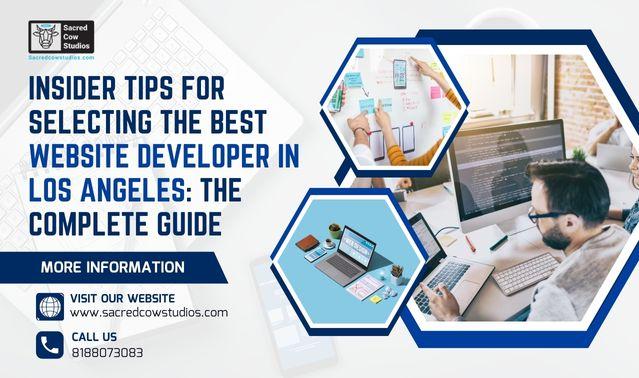
Unlocking Success with Top E-commerce Web Developers in Los Angeles
When it comes to thriving in the digital marketplace, having a top-notch e-commerce website is essential. But not just any website will do—you need a platform that’s engaging,

Our award-winning, highly acclaimed digital marketing agency services have propelled us to become the best website design company in Los Angeles! Our agency incorporates innovative design with cutting-edge functionality that complements your business every step of the way. We believe in a collaborative process where your input and approval are greatly appreciated. Our websites are built with your target audience in mind for visually appealing and impactful web solutions. Our affordable web developers in Los Angeles offer a seamless and highly enriched experience in the process of developing your site. Whether you’re a small business, an enterprise, a startup, or an entrepreneur, our website design and development services are tailor-made to suit your requirements. As a leading digital marketing agency in Los Angeles, our goal is to ensure that our web solutions give you an edge over your competitors and dominate the market!
We leverage highly effective and impactful digital marketing strategies, which can make marketing campaigns successful and drive high results. Our marketing experts help you grow your online business with targeted strategies and solutions tailor-made to your business goals. Our marketing solutions assist in business growth and in customer retention. Our team helps you to evoke genuine interest and excitement among your customers and deliver highly segmented and personalized content journeys. Sacred Cow Studios prides itself on being a digital marketing agency in Los Angeles known for exceptional social media and creative branding solutions. We also specialize in search engine optimization and pay-per-click marketing services. We are setting a new standard for how brands communicate and resonate through digital marketing. Our results-oriented strategies give us complete clarity on how to approach our target audience and convert them into engaged customers and brand advocates.
We focus on a hands-on approach with design and prototyping processes starting from day one. Our founder David K started the business about 6 years ago with a vision of providing innovative services with competitive pricing solutions. With a motto of unity in diversity, our multinational team consists of overseas developers, which allows us to provide the best website design services.
We are a one-of-a-kind digital marketing agency in Los Angeles offering our services for nearly half the price of USA-based developers. Our team consists of more than 100 developers with a demonstrated capability of handling projects of all sizes. Connect with us to discuss your business needs and directly connect with our founder for a review of your idea and a get a free proposal.

Our team of industry experts have the knowledge and skills to handle complex projects and provide expert advice to clients.
Our digital marketing services deliver high-quality work quickly and efficiently, ensuring that projects are completed on time and on budget.
The company is committed to providing high-quality work that exceeds client expectations, ensuring that clients get the most value for their investment.
Whether it’s optimizing a website’s for search engine or designing user experience, our digital marketing services are focused on achieving tangible results for our clients.
From coding to design to marketing, our team is meticulous in their attention to detail, ensuring that every aspect of a project is executed to the highest standard.
Our team provides easily accessible customer service as part of our digital marketing agency services, ensuring clients remain supported throughout the project and beyond.
Websites Designed & Developed
Mobile Apps Published in Google Play Store & Apple App Store
Keywords Ranking on Google’s 1st Page
Google Ad Campaigns

When it comes to thriving in the digital marketplace, having a top-notch e-commerce website is essential. But not just any website will do—you need a platform that’s engaging,

Do you know that with web designers in Los Angeles, you get an increase in your online presence?

Developing a website requires the application of specialised web development technologies.
Most websites designed by us go from planning through launch in approximately 8-12 weeks depending on complexity and features, plus ongoing maintenance to keep your site up-to-date and secure.
Yes, we build custom online stores with secure payment integration, mobile responsiveness and inventory management, all tailored for your audience to increase conversions and optimize shopping experiences.
We use modern CMS platforms like WordPress, Shopify and custom frameworks, ensuring scalability, ease of updates and seamless integrations like CRM, ERP and third-party APIs.
After launch we offer maintenance packages including uptime monitoring, security patches, content updates and performance optimization, so your website stays fresh, fast and functional.
We combine global-distributed development teams with Los Angeles-based project oversight, offering high-quality work at competitive pricing with a focus on conversions and measurable results.
Absolutely, we build iOS and Android native or hybrid mobile apps that extend your online presence, integrate with your website and engage users beyond standard browser experiences.
We begin with a technical audit, then optimize site architecture, on-page content, metadata and backlinks, ensuring your site is ready to rank and perform in competitive search landscapes.
Our services include social media management, PPC campaigns, content marketing and conversion tracking, all customized to your business goals and designed for measurable growth and retention.
Yes, we support multilingual content, region-specific domains, and localization strategies, making it easier for your brand to expand globally without losing performance or user experience.
We track key metrics like traffic growth, conversion rates, bounce rates and page load times, provide you with detailed reports and iterate accordingly to maximize ROI and user engagement.